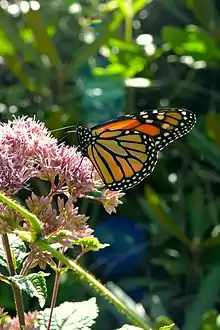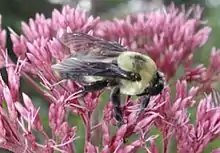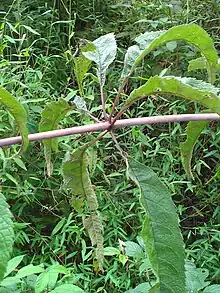| Joe-Pye weeds | |
|---|---|
 | |
| Joe-Pye weed in flower | |
 | |
| Scientific classification | |
| Kingdom: | Plantae |
| Clade: | Tracheophytes |
| Clade: | Angiosperms |
| Clade: | Eudicots |
| Clade: | Asterids |
| Order: | Asterales |
| Family: | Asteraceae |
| Subfamily: | Asteroideae |
| Tribe: | Eupatorieae |
| Genus: | Eutrochium Raf. |
| Synonyms[1] | |
Eutrochium is a North American genus of herbaceous flowering plants in the family Asteraceae. They are commonly referred to as Joe-Pye weeds. They are native to the United States and Canada, and have non-dissected foliage and pigmented flowers. The genus includes all the purple-flowering North American species of the genus Eupatorium as traditionally defined,[2] and most are grown as ornamental plants, particularly in Europe and North America.
Taxonomy
Eupatorium has recently undergone some revision and has been broken up into smaller genera.[3][4] Joe Pye weeds were initially included in the genus Eupatorium, but as early as the 19th century Franco-American botanist Constantine Samuel Rafinesque proposed separating them into their own genus Eutrochium.[5][lower-alpha 1] Unaware of this,[5] research botanists Robert M. King and Harold Robinson proposed assigning them to a new genus Eupatoriadelphus in 1970.[7] This was widely accepted, and Joe Pye weeds began to be referred to as such.[5]
In 1987, Robinson and King reincluded the genus Eupatoriadelphus in Eupatorium, while recognizing this former genus as being the same group of plants as Rafinesque's Eutrochium.[8] This decision was also widely accepted.[9]
Based on chloroplast DNA analysis published by Edward E, Schilling et al. in 1999,[10] the Joe Pye weeds were again separated into their own genus, Eutrochium,[11] as Eutrochium is the senior synonym of Eupatoriadelphus.[12][13] This usage quickly became formalized.[5]
Eupatorium in the revised sense (about 42 species of white-flowered plants from the temperate Northern hemisphere) is apparently a close relative of Eutrochium. In addition to flower color, another difference between Eutrochium and Eupatorium is that the former has mostly whorled leaves and the latter mostly opposite ones.[13][14] Eupatorium and Eutrochium are both placed in the subtribe Eupatoriinae, but South American plants which have sometimes been placed in that subtribe, such as Stomatanthes, seem to belong elsewhere in the tribe Eupatorieae.[4]
- Species[15]
- Eutrochium dubium (Willdenow ex Poiret) E. E. Lamont – coastal plain Joe-Pye weed
- Eutrochium fistulosum (Barratt) E. E. Lamont – hollow Joe-Pye weed
- Eutrochium maculatum (Linnaeus) E. E. Lamont – spotted Joe-Pye weed[16]
- Eutrochium purpureum (Linnaeus) E. E. Lamont – sweet Joe-Pye weed, green-stemmed Joe-Pye weed, queen of the meadow, gravel root, kidney root, purple boneset
- Eutrochium steelei (E. E. Lamont) E. E. Lamont
Uses
All of the Joe Pye weed species except E. steelei are widely cultivated as ornamental landscape plants.[17] Cultivars have been developed for a more compact habit (e.g. E. dubium ‘Little Joe’, E. dubium ‘Baby Joe’, E. maculatum ‘Little Red’) and varied flower color.
Joe Pye weeds have traditionally been ascribed with medicinal powers. A peer-reviewed study suggests that Joe Pye of plant fame was a Mohican sachem named Schauquethqueat who lived in the mission town of Stockbridge, Massachusetts from c. 1740 to c. 1785 and who took as his Christian name, Joseph Pye.[18] Sources (although without citation) claim the plant was used to treat typhus outbreaks[19] and for the treatment of kidney stones and other urinary tract ailments.[20]


Notes
- ↑ Or as Eupatorium sect. Verticillatum by de Candolle in 1836.[6]
References
- ↑ "Eutrochium". Tropicos. Missouri Botanical Garden. Retrieved 2018-08-26.
- ↑ Siripun, Kunsiri Chaw & Schilling, Edward E. (2006): Molecular confirmation of the hybrid origin of Eupatorium godfreyanum (Asteraceae). Am. J. Bot. 93(2): 319-325. PDf fulltext
- ↑ Ito, Motomi; Watanabe, Kuniaki; Kita, Yoko; Kawahara, Takayuki; Crawford, D.J. & Yahara, Tetsukazu (2000): Phylogeny and Phytogeography of Eupatorium (Eupatorieae, Asteraceae): Insights from Sequence Data of the nrDNA ITS Regions and cpDNA RFLP. Journal of Plant Research 113(1): 79-89. doi:10.1007/PL00013913 (HTML abstract)
- 1 2 Schmidt, Gregory J. & Schilling, Edward E. (2000): Phylogeny and biogeography of Eupatorium (Asteraceae: Eupatorieae) based on nuclear ITS sequence data. Am. J. Bot. 87(5): 716-726. doi:10.2307/2656858 PMID 10811796 PDF fulltext
- 1 2 3 4 "Spotted Joe Pye weed (Eutrochium maculatum)" at Minnesota Seasons web page. Retrieved 25 February 2023.
- ↑ Alan Whittemore. "The Sectional Nomenclature of Eupatorium (Asteraceae)." Taxon. 36:3 (August 1987): 619. JSTOR 1221856 doi:10.2307/1221856
- ↑ R. M. King and H. Robinson. "Eupatorium, a Composite Genus of Arcto-Tertiary Distribution." Taxon. 19.5: 770 (October 1970). JSTOR 3562296 doi:10.2307/1219289
- ↑ Robert Merrill King and Harold Robinson. The Genera of the Eupatorieae (Asteraceae). Missouri Botanical Garden, 1987. p. 65. ISSN 0161-1542
- ↑ Eric E. Lamont. Taxonomy of Eupatorium Section Verticillata (Asteraceae). New York Botanical Garden, 1995. ISBN 9780893273910
- ↑ Edward E. Schilling, Jose L. Panero and Patricia B. Cox. "Chloroplast DNA restriction site data support a narrowed interpretation of Eupatorium (Asteraceae)." Plant Systematics and Evolution. 219(3/4):221 (January 1999).
- ↑ Gregory J Schmidt and Edward E Schilling. "Phylogeny and biogeography of Eupatorium (Asteraceae: Eupatorieae) based on nuclear ITS sequence data." American Journal of Botany. 87(5): 716. (May 2000). doi:10.2307/2656858
- ↑ Lamont, Eric E. (2004): New combinations in Eutrochium, an earlier name for Eupatoriadelphus. Sida 21: 901-902.
- 1 2 Lamont, Eric E. (2006). "Eutrochium". In Flora of North America Editorial Committee (ed.). Flora of North America North of Mexico (FNA). Vol. 21. New York and Oxford: Oxford University Press – via eFloras.org, Missouri Botanical Garden, St. Louis, MO & Harvard University Herbaria, Cambridge, MA.
- ↑ Siripun, Kunsiri Chaw; Schilling, Edward E. (2006). "Eupatorium". In Flora of North America Editorial Committee (ed.). Flora of North America North of Mexico (FNA). Vol. 21. New York and Oxford: Oxford University Press – via eFloras.org, Missouri Botanical Garden, St. Louis, MO & Harvard University Herbaria, Cambridge, MA.
- ↑ The Plant List, search for Eutrochium
- ↑ "Eupatorium maculatum" at Plants4Bees. Archived on 3 March 2016.
- ↑ Richard Hawke. "A Comparative Study of Joe-Pye Weeds (Eutrochium spp.) and Their Relatives." Plant Evaluation Notes. Chicago Botanic Garden. 37 (2014).
- ↑ Pearce, Richard B & Pringle, James S. (2017). Joe Pye, Joe Pye’s Law, and Joe-Pye-Weed: The History and Eponymy of the Common Name Joe-Pye-Weed for Eutrochium Species (Asteraceae),The Great Lakes Botanist, 56(3-4):177-200.Fulltext
- ↑ Audubon Society (1988). The Audubon Society Field Guide to North American Wildflowers, Eastern Region. New York: Alfred A. Knopf, Inc.
- ↑ Hemmerly, T. E. (2000). Appalachian Wildflowers. Athens, Georgia: University of Georgia Press.
![]() Media related to Eutrochium at Wikimedia Commons
Media related to Eutrochium at Wikimedia Commons